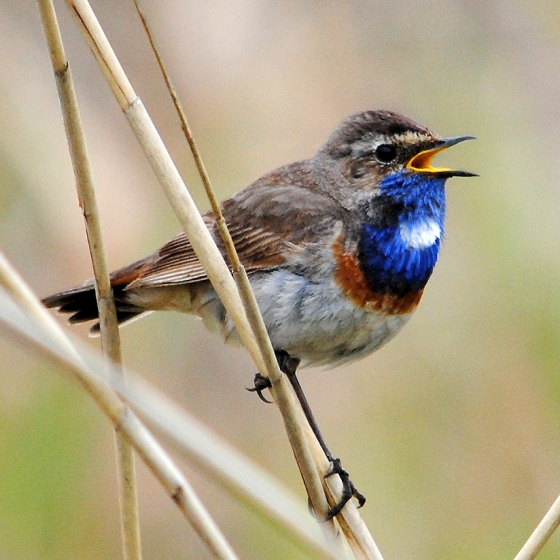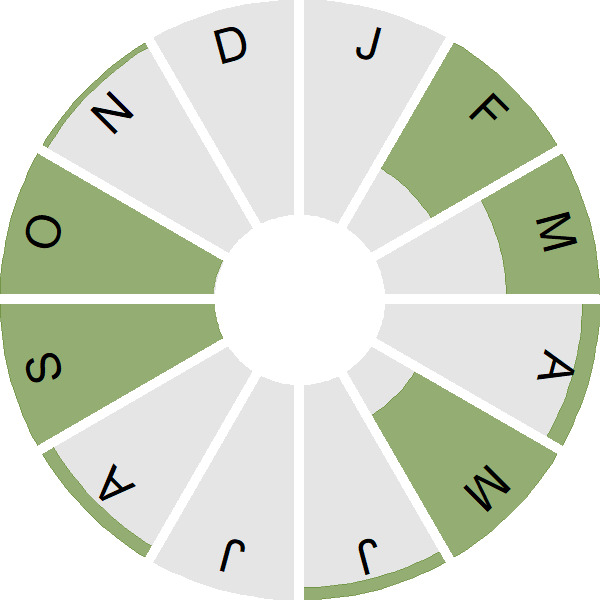Bluethroat

Introduction
This striking species shows tremendous variation in the intensity of its blue throat and in the colour and shape of any throat spot.
Although predominantly a scarce visitor to our shores, Bluethroat has bred here on a number of occasions.
Records come from throughout the year but with spring and autumn peaks, the latter the larger of these.

Key Stats
Identification
Songs and Calls
Song:
Status and Trends
Conservation Status
Population Size
Population Change
The Bluethroat is an occasional breeder in the UK with the most recent breeding record in 2016 (Ince 2018).
Distribution
This species is a rare vagrant and was recorded during Bird Atlas 2007–11 as shown on the map.
Occupied 10-km squares in UK
or view it on Bird Atlas Mapstore.
or view it on Bird Atlas Mapstore.
European Distribution Map
Distribution Change
This vagrant is too rarely reported to map distribution change.
Change in occupied 10-km squares in the UK
Seasonality
Bluethroat is a scarce migrant, with two subspecies; white-spotted birds can occur from late winter onwards whereas red-spotted birds are more likely to be seen in May. Also a scarce migrant in late autumn.
Weekly pattern of occurrence
The graph shows when the species is present in the UK, with taller bars indicating a higher likelihood of encountering the species in appropriate regions and habitats.

Movement
Britain & Ireland movement
Foreign locations of birds ringed or recovered in Britain & Ireland
Dots show the foreign destinations of birds ringed in Britain & Ireland, and the origins of birds ringed overseas that were subsequently recaptured, resighted or found dead in Britain & Ireland. Dot colours indicate the time of year that the species was present at the location.
- Winter (Nov-Feb)
- Spring (Mar-Apr)
- Summer (May-Jul)
- Autumn (Aug-Oct)

European movements
EuroBirdPortal uses birdwatcher's records, such as those logged in BirdTrack to map the flows of birds as they arrive and depart Europe. See maps for this species here.
The Eurasian-African Migration Atlas shows movements of individual birds ringed or recovered in Europe. See maps for this species here.
Biology
Productivity and Nesting
Nesting timing
Egg measurements
Clutch Size
Survival and Longevity
Survival is shown as the proportion of birds surviving from one year to the next and is derived from bird ringing data. It can also be used to estimate how long birds typically live.
View number ringed each year in the Online Ringing Report.
Biometrics
Wing length and body weights are from live birds (source).
Wing length
Body weight
Ring Size
Classification, names and codes
Classification and Codes
- Order: Passeriformes
- Family: Muscicapidae
- Scientific name: Luscinia svecica
- Authority: Linnaeus, 1758
- BTO 2-letter code: BU
- BTO 5-letter code: BLUTH
- Euring code number: 11060
Alternate species names
- Catalan: cotxa blava
- Czech: slavík modrácek
- Danish: Blåhals
- Dutch: Blauwborst
- Estonian: sinirind
- Finnish: sinirinta
- French: Gorgebleue à miroir
- Gaelic: Òranaiche
- German: Blaukehlchen
- Hungarian: kékbegy
- Icelandic: Blábrystingur
- Irish: Gormphíb
- Italian: Pettazzurro
- Latvian: zilriklite
- Lithuanian: paprastoji melyngurkle
- Norwegian: Blåstrupe
- Polish: podrózniczek
- Portuguese: pisco-de-peito-azul
- Slovak: slávik modrák
- Slovenian: modra tašcica
- Spanish: Ruiseñor pechiazul
- Swedish: blåhake
- Welsh: Bronlas Smotyn
Research
Causes of Change and Solutions
Causes of change
The Bluethroat is currently an occasional breeder in the UK.The potential future drivers of change are unclear.

